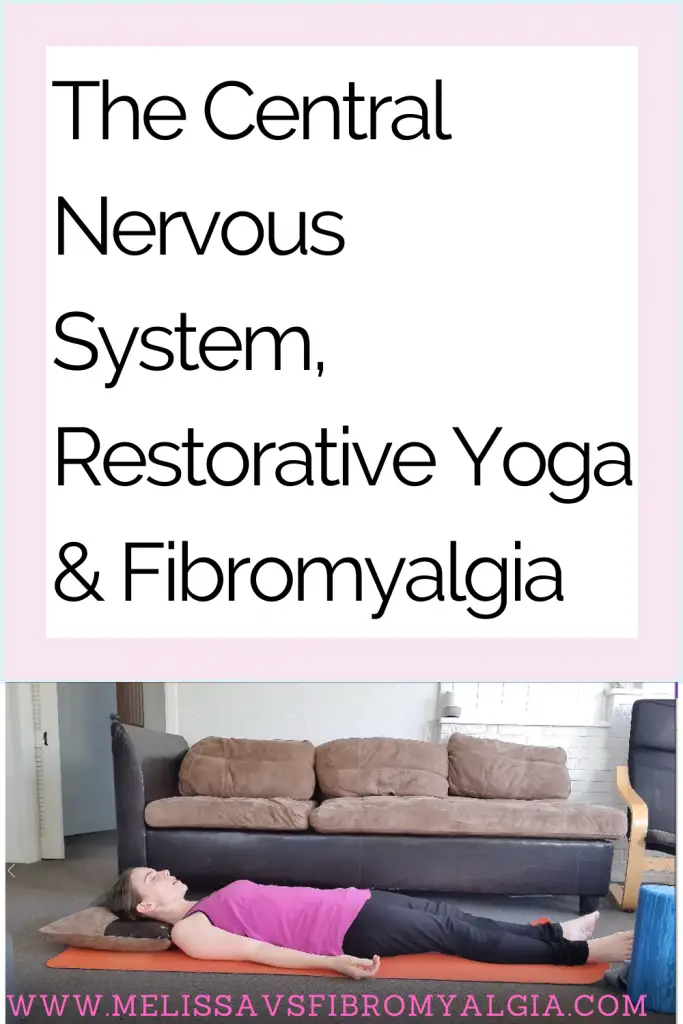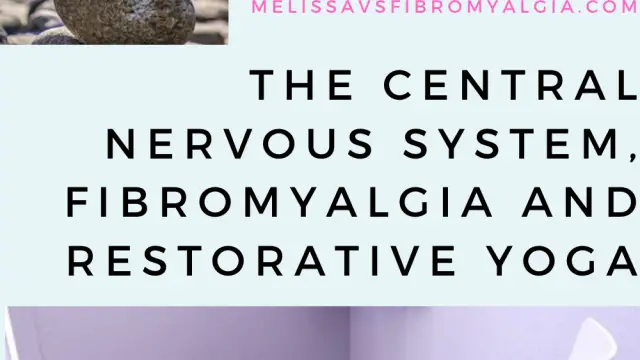Last Updated on October 27, 2023 by melissanreynolds
Let’s chat central nervous system, restorative yoga and fibromyalgia. A lot of research suggests that Fibromyalgia is the result of central nervous system dysfunction – specifically an overactive nervous system, stressing and exhausting the brain (Dennis W. Dobritt, Fibromyalgia – A Brief Overview).
Having lived it for over 15 years, I would be inclined to agree.
It is not the sole problem, but it certainly causes physiological flow on effects, even after we have learned to calm it down again.
Like perhaps a switch gets flipped in our brain from some kind of trauma – an illness, childbirth, experiencing abuse of some kind, experiencing a natural disaster etc. and then it is very hard to turn it off.

The simplest way to put it
Simply put – we are too often in “fight or flight” mode and struggle to active the “rest and digest” mode.
Fight or flight is that response we have to stressful stimuli – a bear chasing us? Energy is diverted to the functions that are needed to fly, or run really fast! We experience that belly full of butterflies on crack, feel shaky, anxious and fearful.
The rest and digest response is that delicious restful feeling when we are totally relaxed – like during a good, gentle massage.
When you have a central nervous system over activation it is like you are stuck in the fight or flight mode. A chronic, low level anxiety that persists that you live with for so long you might not recognize it as anxiety – because you try to adapt.
This causes real problems in the body. If our energy is constantly diverted to scanning for threats and getting to run or protect ourselves, how can we have energy for normal functions? Digestion itself takes a lot of energy. Then being unable to drop into deep sleep because our brain is watching for threats, even more energy is drained. It is a big, vicious cycle.
What are some of the symptoms of a central nervous system over activity?
- Anxiety
- Insomnia
- Breathlessness
- Inability to relax
- Poor digestion
- High blood pressure
- Fear
- Fatigue
- Lethargy
What are the benefits of a balanced central nervous system?
- Better sleep
- Less pain
- Reduced anxiety
- Relaxation
- Good digestion
- Heal well
- Have enough energy
- Less brain fog
Yes please to all of these!!

So, how can we treat an over activated central nervous system?
- Rest
- Sleep (easier said than done, I know)
- Gentle breathing
- Mindfulness
- Meditation – especially Yoga Nidra
- Restorative yoga
- Removal of perpetuating factors
It’s not a quick fix…
From personal experience, I can tell you it is not a quick fix either. I have meditated, done yoga, worked on sleep, removed myself from perpetuating factors (as best as I can) and it is still a work in progress.
And – although my central nervous system is MUCH calmer, I am not magically healed. But with my whole of life plan in place, including a heavy amount of the above treatments, I am feeling much better.
For a long time meditation was my thing, particularly yoga Nidra guided meditation, because I needed the profound rest it offered immediately.
Gentle breathing was a great tool to reduce some of the constant tension in my chest, shoulders and neck. It is also fantastic at helping to calm the central nervous system when it gets flared again.
Right now, though, my jam is restorative yoga.
Why? Because it is a little less passive and easier to access for those who find it difficult to just sit still and breathe.
What are the benefits of restorative yoga?
- Enhances flexibility
- Total relaxation of body and mind
- Improves capacity for healing
- Balances the central nervous system
- Helps us tune into our body

What is restorative yoga?
Well this is a big question. Because a lot of people get it confused with yin yoga.
Restorative yoga is a passive practice that utilises props (cushions, bolsters, blocks etc.) to achieve total support. Yin yoga also holds poses for longer than other yoga traditions, around five minutes or so, but it is looking for deep sensation and it is energetically more strenuous (while still being relatively gentle).
In a restorative yoga class you will have your props around you, it will be a calm atmosphere and you will like only do a few poses. There may or may not be calming music and essential oils.
The point of the props are to help you hold the pose with ease and melt into it. Calming the central nervous system.
Want to try a class?
Want ONE place to teach you the tools to calm an overactivated nervous system?
Join us in Yoga for the Chronic Life virtual yoga studio.
We have bed yoga, restorative yoga, breathing, meditations, mindfulness training, seated yoga and much more.

Sources
In this post I have taken my combined knowledge and written it up as you see. For some sources and further reading see below…
https://irenelyon.com/2018/09/30/9-benefits-nervoussystem-regulated/
https://www.everythingzoomer.com/health/2018/08/20/yoga-after-50-yin-restorative/
https://chopra.com/articles/10-benefits-of-restorative-yoga
https://www.yogajournal.com/yoga-101/why-restorative-yoga-is-the-most-advanced-practice
https://www.ekhartyoga.com/articles/practice/why-restorative-yoga



12 thoughts on “The Central Nervous System, Restorative Yoga and Fibromyalgia”